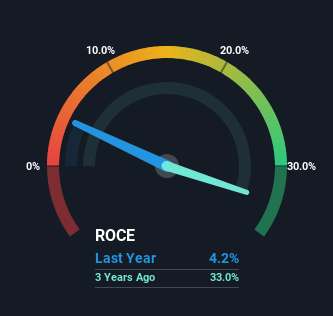Some Investors May Be Worried About Nanofilm Technologies International's (SGX:MZH) Returns On Capital
Finding a business that has the potential to grow substantially is not easy, but it is possible if we look at a few key financial metrics. Firstly, we'd want to identify a growing return on capital employed (ROCE) and then alongside that, an ever-increasing base of capital employed. Ultimately, this demonstrates that it's a business that is reinvesting profits at increasing rates of return. In light of that, when we looked at Nanofilm Technologies International (SGX:MZH) and its ROCE trend, we weren't exactly thrilled.
Return On Capital Employed (ROCE): What Is It?
For those who don't know, ROCE is a measure of a company's yearly pre-tax profit (its return), relative to the capital employed in the business. Analysts use this formula to calculate it for Nanofilm Technologies International:
Return on Capital Employed = Earnings Before Interest and Tax (EBIT) ÷ (Total Assets - Current Liabilities)
0.042 = S$22m ÷ (S$557m - S$41m) (Based on the trailing twelve months to June 2023).
Thus, Nanofilm Technologies International has an ROCE of 4.2%. In absolute terms, that's a low return, but it's much better than the Chemicals industry average of 1.8%.
See our latest analysis for Nanofilm Technologies International

Above you can see how the current ROCE for Nanofilm Technologies International compares to its prior returns on capital, but there's only so much you can tell from the past. If you'd like to see what analysts are forecasting going forward, you should check out our free report for Nanofilm Technologies International.
What Does the ROCE Trend For Nanofilm Technologies International Tell Us?
In terms of Nanofilm Technologies International's historical ROCE movements, the trend isn't fantastic. Over the last five years, returns on capital have decreased to 4.2% from 27% five years ago. And considering revenue has dropped while employing more capital, we'd be cautious. If this were to continue, you might be looking at a company that is trying to reinvest for growth but is actually losing market share since sales haven't increased.
On a side note, Nanofilm Technologies International has done well to pay down its current liabilities to 7.4% of total assets. So we could link some of this to the decrease in ROCE. What's more, this can reduce some aspects of risk to the business because now the company's suppliers or short-term creditors are funding less of its operations. Since the business is basically funding more of its operations with it's own money, you could argue this has made the business less efficient at generating ROCE.
Our Take On Nanofilm Technologies International's ROCE
In summary, we're somewhat concerned by Nanofilm Technologies International's diminishing returns on increasing amounts of capital. This could explain why the stock has sunk a total of 84% in the last three years. That being the case, unless the underlying trends revert to a more positive trajectory, we'd consider looking elsewhere.
If you'd like to know about the risks facing Nanofilm Technologies International, we've discovered 1 warning sign that you should be aware of.
If you want to search for solid companies with great earnings, check out this free list of companies with good balance sheets and impressive returns on equity.
Valuation is complex, but we're here to simplify it.
Discover if Nanofilm Technologies International might be undervalued or overvalued with our detailed analysis, featuring fair value estimates, potential risks, dividends, insider trades, and its financial condition.
Access Free AnalysisHave feedback on this article? Concerned about the content? Get in touch with us directly. Alternatively, email editorial-team (at) simplywallst.com.
This article by Simply Wall St is general in nature. We provide commentary based on historical data and analyst forecasts only using an unbiased methodology and our articles are not intended to be financial advice. It does not constitute a recommendation to buy or sell any stock, and does not take account of your objectives, or your financial situation. We aim to bring you long-term focused analysis driven by fundamental data. Note that our analysis may not factor in the latest price-sensitive company announcements or qualitative material. Simply Wall St has no position in any stocks mentioned.
About SGX:MZH
Nanofilm Technologies International
Provides nanotechnology solutions in Singapore, China, Japan, and Vietnam.
Flawless balance sheet with proven track record.
Similar Companies
Market Insights
Community Narratives



